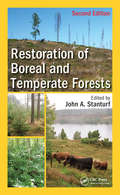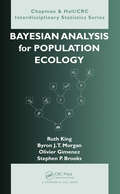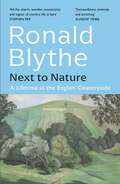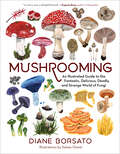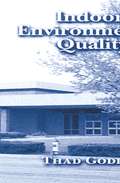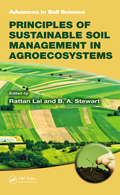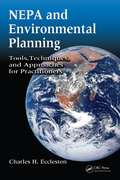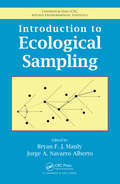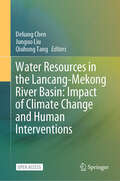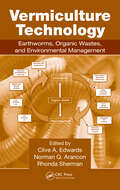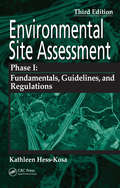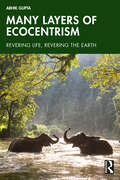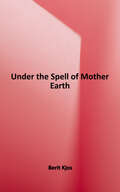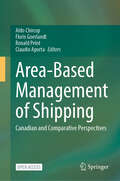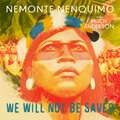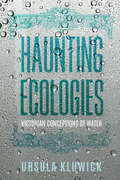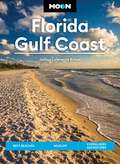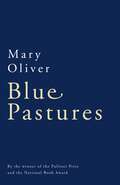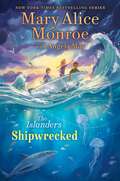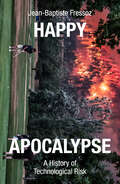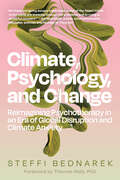- Table View
- List View
Land Carbon Cycle Modeling: Matrix Approach, Data Assimilation, Ecological Forecasting, and Machine Learning
by Yiqi LuoCarbon moves through the atmosphere, through the oceans, onto land, and into ecosystems. This cycling has a large effect on climate – changing geographic patterns of rainfall and the frequency of extreme weather – and is altered as the use of fossil fuels adds carbon to the cycle. The dynamics of this global carbon cycling are largely predicted over broad spatial scales and long periods of time by Earth system models. This book addresses the crucial question of how to assess, evaluate, and estimate the potential impact of the additional carbon to the land carbon cycle. The contributors describe a set of new approaches to land carbon cycle modeling for better exploring ecological questions regarding changes in carbon cycling; employing data assimilation techniques for model improvement; doing real- or near-time ecological forecasting for decision support; and combining newly available machine learning techniques with process-based models to improve prediction of the land carbon cycle under climate change. This new edition includes seven new chapters: machine learning and its applications to carbon cycle research (five chapters); principles underlying carbon dioxide removal from the atmosphere, contemporary active research and management issues (one chapter); and community infrastructure for ecological forecasting (one chapter).Key Features Helps readers understand, implement, and criticize land carbon cycle models Offers a new theoretical framework to understand transient dynamics of the land carbon cycle Describes a suite of modeling skills – matrix approach to represent land carbon, nitrogen, and phosphorus cycles; data assimilation and machine learning to improve parameterization; and workflow systems to facilitate ecological forecasting Introduces a new set of techniques, such as semi-analytic spin-up (SASU), unified diagnostic system with a 1-3-5 scheme, traceability analysis, and benchmark analysis, and PROcess-guided machine learning and DAta-driven modeling (PRODA) for model evaluation and improvement Reorganized from the first edition with seven new chapters added Strives to balance theoretical considerations, technical details, and applications of ecosystem modeling for research, assessment, and crucial decision-making
Restoration of Boreal and Temperate Forests (Integrative Studies in Water Management & Land Development)
by John A. StanturfThis substantially updated new edition reflects the growing recognition that large areas of forests are degraded globally. This edition describes forest restoration in the context of rapid social, economic, environmental, and climate change. Covering the last decade's significant advances in forest restoration concepts and practice, this edition has 16 new chapters and 19 thoroughly revised chapters. This book is an excellent source of information for researchers, managers, policymakers, and graduate students in forestry and ecology.
Bayesian Analysis for Population Ecology (Chapman & Hall/CRC Interdisciplinary Statistics)
by Ruth King Byron Morgan Olivier Gimenez Steve BrooksNovel Statistical Tools for Conserving and Managing PopulationsBy gathering information on key demographic parameters, scientists can often predict how populations will develop in the future and relate these parameters to external influences, such as global warming. Because of their ability to easily incorporate random effects, fit state-space mode
Next to Nature: A Lifetime in the English Countryside
by Ronald Blythe'All the charm, wonder, eccentricity and vigour of country life is here in these pages, and told with such engaging directness, detail and colour . . . Bliss' STEPHEN FRY'A capacious work that contains multitudes . . . a work to amble through, seasonally, relishing the vivid dashes of colour and the precision and delicacy of the descriptions' THE SPECTATOR'My favourite read of the year . . . warm, funny and moving' SUNDAY TIMES'A writer whose pages you turn and then turn back immediately to re-read, relish and get by heart' SUSAN HILL, SUNDAY TELEGRAPHRonald Blythe lived at the end of an overgrown farm track deep in the rolling countryside of the Stour Valley, on the border between Suffolk and Essex. His home was Bottengoms Farm, a sturdy yeoman's house once owned by the artist John Nash. From here, Blythe spent almost half a century observing the slow turn of the agricultural year, the church year and village life in a series of rich, lyrical rural diaries.Beginning with the arrival of snow on New Year's Day and ending with Christmas carols sung in the village church, Next to Nature invites us to witness a simple life richly lived. With gentle wit and keen observation Blythe meditates on his life and faith, on literature, art and history, and on our place in the landscape.It is a celebration of one of our greatest nature writers, and an unforgettable ode to the English countryside.
Mushrooming: An Illustrated Guide To The Fantastic, Delicious, Deadly, And Strange World Of Fungi
by Diane Borsato“A merry, idiosyncratic guide, charmingly illustrated.”—Eugenia Bone, The Wall Street Journal An illustrated guide to over 100 types of mushrooms, offering insights and stories about these mysterious organisms An incredible diversity of fungi is flourishing all around us, not just in the forest but in parks, markets, and even museums. Once you know how to look, you can find mushrooms named after fairies and demons, mushrooms that look so much like woodland birds they are shot at by hunters, mushrooms that glow in the dark . . . and so much more. Beyond serving as a guide for identification, Mushrooming explores how “the quiet hunt” can radically expand our perspectives, connect us to nature, and enrich our lives. Whether you’re a beginner forager or an expert mycophile, this is the perfect handbook to spark your curiosity and deepen your appreciation for the fantastic, delicious, deadly, and strange world of fungi.
Indoor Environmental Quality
by Thad GodishWhen we think of indoor pollution, we usually think of conditions originating from faulty ventilation systems, second hand smoke, and other air borne pollutants. Taking an in-depth, hard science look at the problems of indoor environmental pollution, Indoor Environmental Quality covers all the major indoor contaminants - inorganic, organic, and bio
Principles of Sustainable Soil Management in Agroecosystems (ISSN)
by Rattan Lal B. A. StewartWith the use of high-level soil management technology, Africa could feed several billion people, yet food production has generally stagnated since the 1960s. No matter how powerful the seed technology, the seedling emerging from it can flourish only in a healthy soil. Accordingly, crop yields in Africa, South Asia, and the Caribbean could be double
NEPA and Environmental Planning: Tools, Techniques, and Approaches for Practitioners
by Charles H. EcclestonA tool for predicting environmental impacts, the National Environmental Policy Act (NEPA) can also be used to predict the impacts of natural disasters and potential terrorist attacks. This book demonstrates how to use NEPA as a framework to support decision-making. It includes examples that demonstrate how NEPA can be efficiently integrated with other processes such as ISO 14001, P2, and Adaptive Management. It provides proven tools, techniques, and approaches for streamlining NEPA and environmental planning strategies that reduce the potential for controversy and criticism. It is the first text that covers recent changes to NEPA and the new CEQ guidance expected to be issued.
Introduction to Ecological Sampling (Chapman & Hall/CRC Applied Environmental Statistics #10)
by Bryan F. J. Manly Jorge A. Navarro AlbertoAn Easy-to-Understand Treatment of Ecological Sampling Methods and Data AnalysisIncluding only the necessary mathematical derivations, Introduction to Ecological Sampling shows how to use sampling procedures for ecological and environmental studies. It incorporates both traditional sampling methods and recent developments in environmental and ecolo
Water Resources in the Lancang-Mekong River Basin: Impact of Climate Change and Human Interventions
by Qiuhong Tang Deliang Chen Junguo LiuThis open access book provides a comprehensive, up-to-date picture of the current state of knowledge covering climate change, surface water change, arsenic pollution, water utilization, water-food-energy nexus, water related hazards, water management, and water governance in the Lancang-Mekong River Basin. Considering the widely concerned fact that the climate change and human intervention induced impacts on water will bring unprecedented threats to human societies and ecosystems, the book intends to support UN’s sustainable development goals through sustainable use of water by providing the most accurate and updated information on climate and water changes in a consistent way. Underlying all aspects of the book is a strong commitment to assessing the science comprehensively, without bias and in a way that is relevant to policy but not policy prescriptive. It can provide implications to support decision-makers and stakeholders for integrated water resources management and sustainable development at all levels.
Vermiculture Technology: Earthworms, Organic Wastes, and Environmental Management
by Rhonda Sherman Clive A. Edwards Norman Q. AranconCo-edited by international earthworm expert Clive A. Edwards, Vermiculture Technology: Earthworms, Organic Wastes, and Environmental Management is the first international, comprehensive, and definitive work on how earthworms and microorganisms interact to break down organic wastes on a commercial basis. Many books cover the importance of composting
Environmental Site Assessment Phase I: A Basic Guide, Third Edition
by Kathleen Hess-KosaExtensively updated to reflect the most recent changes to the All Appropriate Inquiries Rule (theRule ) and the ASTM Environmental Site Assessment Standard (theStandard ), Environmental Site Assessment Phase 1, Third Edition provides a valuable guide to the techniques of performing Phase 1 site assessment. Promoting a better understandin
Many Layers of Ecocentrism: Revering Life, Revering the Earth
by Abhik GuptaThis book unveils the myriad streams of ecocentric thoughts that have been flowing through the human mind – in indigenous communities, in the wisdom of philosophers, in the creative expressions of poets and writers – sometimes latent, but sometimes more explicit. The strength of this book lies in the fact that it attempts to show that ecocentrism had not emerged suddenly as a distinct line of philosophical thought or found its place among the various normative approaches toward nature, but the seeds of ecocentrism had always been running through human societies. Thus, this book not only emphasizes the “unity of life” but also reveals the inherent unity of all hues of ecocentrism. The book adopts a multidisciplinary approach, which is essential to dwell on a topic like ecocentrism which permeates the domains of disciplines as disparate as science, philosophy, religion, normative ethics, myths and folklore, poetry, and literature, among others. Despite this eclectic approach, the book attempts to maintain continuity among the chapters and present these concepts in a simple form that will be easily accessible by readers from all conceivable backgrounds. This book would be useful to the students, researchers, and faculty from the fields of ecology and environmental science, philosophy, sociology, religious studies, and literature. It will also be an indispensable companion for all nature lovers, activists, and general readers interested in the emergence and evolution of environmental thoughts.
Under the Spell of Mother Earth
by Berit KjosThis book alerts readers to the signs of Goddess worship--even in America--and warns against elevating Mother Earth from legend to religion, basing environmental concerns in ancient pagan practices, depersonalizing God and people, and seeking a Goddess Mother as the source of life.
Area-Based Management of Shipping: Canadian and Comparative Perspectives
by Claudio Aporta Aldo Chircop Floris Goerlandt Ronald PelotThis open access book fills a gap in the literature on shipping in a number of cross-cutting fields (including marine transportation law and policy, law of the sea, Indigenous rights, marine environmental management, and risk and safety studies). Moreover, the book includes a focus on the consideration of Indigenous rights in shipping, a topic of emerging importance. There are, to our knowledge, no directly competing titles with the same interdisciplinary approach to conceptualize, understand, and describe best practices for area-based management approaches. There are, however, related titles which cover some aspects of area-based management, usually from narrow disciplinary perspectives. Area-based management in the governance of shipping has become a useful and effective approach to promote maritime safety, maritime security, and pollution prevention and to mitigate the adverse impacts of shipping on the marine environment and coastal communities. Based on the results of a research project and a major workshop convened at Dalhousie University in Canada, this book consists of multidisciplinary studies and analyses of major issues pertaining to area-based management in shipping from a comparative perspective, but with the principal focus on Canada. The book contains both theoretical and empirical contributions.
Next to Nature: A Lifetime in the English Countryside
by Ronald Blythe'All the charm, wonder, eccentricity and vigour of country life is here in these pages, and told with such engaging directness, detail and colour . . . Bliss' STEPHEN FRY'A capacious work that contains multitudes . . . a work to amble through, seasonally, relishing the vivid dashes of colour and the precision and delicacy of the descriptions' THE SPECTATOR'My favourite read of the year . . . warm, funny and moving' SUNDAY TIMES'A writer whose pages you turn and then turn back immediately to re-read, relish and get by heart' SUSAN HILL, SUNDAY TELEGRAPHRonald Blythe lived at the end of an overgrown farm track deep in the rolling countryside of the Stour Valley, on the border between Suffolk and Essex. His home was Bottengoms Farm, a sturdy yeoman's house once owned by the artist John Nash. From here, Blythe spent almost half a century observing the slow turn of the agricultural year, the church year and village life in a series of rich, lyrical rural diaries.Beginning with the arrival of snow on New Year's Day and ending with Christmas carols sung in the village church, Next to Nature invites us to witness a simple life richly lived. With gentle wit and keen observation Blythe meditates on his life and faith, on literature, art and history, and on our place in the landscape.It is a celebration of one of our greatest nature writers, and an unforgettable ode to the English countryside.
Perennial Ceremony: Lessons and Gifts from a Dakota Garden
by Teresa PetersonTravel through a garden&’s seasons toward healing, reclamation, and wholeness—for us, and for our beloved relative, the Earth In this rich collection of prose, poetry, and recipes, Teresa Peterson shares how she found refuge from the struggle to reconcile her Christianity and Dakota spirituality, discovering solace and ceremony in communing with the earth. Observing and embracing the cycles of her garden, she awakens to the constant affirmation that healing and wellness can be attained through a deep relationship with land, plants, and waters. Dakota people call this way of seeing and being in the world mitakuye owasin: all my relations. Perennial Ceremony brings us into this relationship, as Peterson guides us through the Dakota seasons to impart lessons from her life as a gardener, gatherer, and lover of the land. We see the awakening of Wetu (spring), a transitional time when nature comes alive and sweet sap flows from maples, and the imperfect splendor of Bdoketu (summer), when rain becomes a needed and nourishing gift. We share in the harvesting wisdom of Ptaŋyetu (fall), a time to savor daylight and reap the garden&’s abundance, and the restorative solitude of Waniyetu (winter), when snow blankets the landscape and sharpens every sound. Through it all, Peterson walks with us along the path that both divides and joins Christian doctrine, everyday spiritual experience, and the healing powers of Indigenous wisdom and spirituality. In this intimate seasonal cycle, we learn how the garden becomes a healing balm. Peterson teaches us how ceremony may be found there: how in the vegetables and flowers, the woods, the hillsides, the river valley—even in the feeding of friends and family—we can reclaim and honor our relationship with Mother Earth. She encourages us to bring perennial ceremony into our own lives, inviting us on a journey that brings us full circle to makoce kiŋ mitakuye: the land is my relative.
We Will Not Be Saved: A memoir of hope and resistance in the Amazon rainforest
by Nemonte Nenquimo** Publishing in the US as WE WILL BE JAGUARS**'I'm here to tell you my story, which is also the story of my people and the story of this forest.'Born into the Waorani tribe of Ecuador's Amazon rainforest, Nemonte Nenquimo was taught about plant medicines, foraging, oral storytelling, and shamanism by her elders. Age 14, she left the forest for the first time to study with an evangelical missionary group in the city. Eventually, her ancestors began appearing in her dreams, pleading with her to return and embrace her own culture.She listened. Two decades later, Nemonte has emerged as one of the most forceful voices in climate-change activism. She has spearheaded the alliance of indigenous nations across the Upper Amazon and led her people to a landmark victory against Big Oil, protecting over a half million acres of primary rainforest. Her message is as sharp as the spears that her ancestors wielded - honed by her experiences battling loggers, miners, oil companies and missionaries.In this astonishing memoir, she partners with her husband Mitch Anderson, founder of Amazon Frontlines, digging into generations of oral history, uprooting centuries of conquest, hacking away at racist notions of Indigenous peoples, and ultimately revealing a life story as rich, harsh and vital as the Amazon rainforest herself.The Waorani language (referred to as Wao Tededo in the audiobook) is one of the world's most endangered languages and is only spoken by around 2,000 people. The Publishers would like to thank Oswando Nenquimo (Opi) and Connie Dickinson as well as the Endangered Languages Archive https://www.elararchive.org/ and the Endangered Languages Documentation Program https://www.eldp.net/ for their valuable support in ensuring accurate pronunciation of Waorani names and terms.
Haunting Ecologies: Victorian Conceptions of Water (Victorian Literature and Culture Series)
by Ursula KluwickVictorians&’ views of water and its role in how the social fabric of Victorian Britain was imagined Water matters like few other substances in people&’s daily lives. In the nineteenth century, it left its traces on politics, urban reform, and societal divisions, as well as on conceptualizations of gender roles. Drawing on the methodology of material ecocriticism, Ursula Kluwick&’s Haunting Ecologies argues that Victorian Britons were keenly aware of aquatic agency, recognizing water as an active force with the ability to infiltrate bodies and spaces. Kluwick reads works by canonical writers such as Braddon, Dickens, Stoker, and George Eliot alongside sanitary reform discourse, court cases, journalistic articles, satirical cartoons, technical drawings, paintings, and maps. This wide-ranging study sheds new light on Victorian-era anxieties about water contamination as well as on how certain wet landscapes such as sewers, rivers, and marshes became associated with moral corruption and crime. Applying ideas from the field of blue humanities to nineteenth-century texts, Haunting Ecologies argues for the relevance of realism as an Anthropocene form.
Moon Florida Gulf Coast: Best Beaches, Wildlife, Everglades Adventures (Moon U.S. Travel Guide)
by Joshua Lawrence Kinser Moon Travel GuidesWhether you're kayaking through mangroves, bodysurfing with manta rays, or sunbathing with a piña colada in hand, soak up the Sunshine State with Moon Florida Gulf Coast. Inside you'll find: Flexible itineraries including a 5-day family vacation, a baseball spring training trip, and a 10-day road trip covering all 700 miles of the Florida Gulf Coast The best spots for outdoor adventures like kayaking, hiking, biking, bird-watching, and fishing, and the best beaches for swimming, sunsets, and seclusion Top activities and unique experiences: Discover the vibrant performing arts scene in Sarasota or stroll through quaint riverfront towns and secluded island enclaves. Unwind on shell-scattered beaches or spot gators in the swampy Everglades. Ride the coasters at Busch Gardens, browse art galleries in Naples, or catch a college baseball game during Spring Training. Sail through the canals of Tampa, kick back at a beachfront oyster bar, and sip a local brew as the sun sets over the ocean Expert advice from Florida local Joshua Lawrence Kinser on where to stay, what to eat, and how to get around by car, bus, or boat Full-color photos and detailed maps throughoutBackground information on the Gulf Coast's landscape, wildlife, history, and culture Experience the best of Florida's Gulf Coast with Moon. For more of the Sunshine State, try Moon Florida Keys.About Moon Travel Guides: Moon was founded in 1973 to empower independent, active, and conscious travel. We prioritize local businesses, outdoor recreation, and traveling strategically and sustainably. Moon Travel Guides are written by local, expert authors with great stories to tell—and they can't wait to share their favorite places with you. For more inspiration, follow @moonguides on social media.
Blue Pastures
by Mary OliverWith consummate craftsmanship, Mary Oliver has fashioned fifteen luminous prose pieces: on nature, writing, and herself and those around her. She praises Whitman, denounces cuteness, notes where to find the extraordinary, and extols solitude.
Shipwrecked (The Islanders #3)
by Mary Alice MonroeJake, Macon, and Lovie fight to survive at sea in this third high-stakes adventure in the middle grade, New York Times bestselling The Islanders series by Mary Alice Monroe!Jake Potter&’s biggest dream finally comes true: he gets his very own boat! And it&’s just in time for another summer of fun on Dewees Island with his best friends, Macon and Lovie. But on their very first fishing trip, the engine dies, and the three friends find themselves adrift at sea. When a storm carries them to a small, uninhabited island far from Dewees, the kids must use every ounce of their strength, courage, and knowledge to survive as they wait for rescue. Will their friendship survive the ultimate test?
Happy Apocalypse: A History of Technological Risk
by Jean-Baptiste FressozHow risk, disasters and pollution were managed and made acceptable during the Industrial RevolutionBeing environmentally conscious is not nearly as modern as we imagine. As a mode of thinking it goes back hundreds of years. Yet we typically imagine ourselves among the first to grasp the impact humanity has on the environment. Hence there is a fashion for green confessions and mea culpas.But the notion of a contemporary ecological awakening leads to political impasse. It erases a long history of environmental destruction. Furthermore, by focusing on our present virtues, it overlooks the struggles from which our perspective arose.In response, Happy Apocalypse plunges us into the heart of controversies that emerged in the eighteenth and nineteenth centuries around factories, machines, vaccines and railways. Jean-Baptiste Fressoz demonstrates how risk was conceived, managed, distributed and erased to facilitate industrialization. He explores how clinical expertise around 1800 allowed vaccination to be presented as completely benign, how the polluter-pays principle emerged in the nineteenth century to legitimize the chemical industry, how safety norms were invented to secure industrial capital and how criticisms and objections were silenced or overcome to establish technological modernity.Societies of the past did not inadvertently alter their environments on a massive scale. Nor did they disregard the consequences of their decisions. They seriously considered them, sometimes with dread. The history recounted in this book is not one of a sudden awakening but a process of modernising environmental disinhibition.
Tate's Wild Rescue
by Jenny TurnbullA sweet, funny picture book about an animal-loving girl who invites wild animals to live in her house and be her best friend--with mixed results! Back matter also offers ideas for children on how they can help both wild and companion animals!Tate loves animals, but she worries about the ones who live in the wild—aren&’t they cold? Hungry? Lonely?She is determined to help and comes up with the perfect plan: she&’ll offer one a better life and they will be best friends! To her surprise, none of the wild animals she invites to live with her are impressed with her offerings—Orca is not interested in the kiddie pool, and Tiger would rather hunt than settle for cookies. Maybe Tate will have to look a bit closer to home to find her pawsitively perfect match. Tate&’s heartfelt hope to rescue a wild animal combined with the blunt hilarity of their responses makes this charming story perfect for anyone wild about animals!
Climate, Psychology, and Change: Reimagining Psychotherapy in an Era of Global Disruption and Climate Anxiety
by Steffi BednarekWith so many immediate and intensifying crises unfolding around us, how can therapists adapt to promote healing and growth?&“As these intriguing essays make clear, some of the finest minds in the world are thinking through the problems and arriving at powerful answers."—Bill McKibben, author, environmentalist, educator, activist, and founder of Third ActWith essays from Francis Weller, Bayo Akomolafe, Hāweatea Holly Bryson, and moreWestern psychotherapy views our practice as a way to bring clients back to baseline &“normal.&” But our society&’s &“normal&” is profoundly unwell: our ways of being reflect the same unsustainable systems that erode our ecosystems, accelerate global destruction, and ultimately extract our humanity. Moving toward healing and purpose in uncertain times means evolving the way we do therapy and the way we think about mental health.Editor and climate psychologist Steffi Bednarek invites us to co-create a field that navigates unknown futures with skill and grace—one that helps clients build resilience and holds space for the uncertainties unfolding before us. She and 32 contributors explore ideas like:Decolonizing therapyUsing therapeutic tools to respond to traumaWhat psychologists can offer movements for social change and climate justiceHelping clients recognize and move past unhelpful responses to climate emergencyNurturing creativity in the face of crisisHolistic and intersectional, this collection reckons with the ways power, colonialism, and capitalism impact our myriad crises—while shaping Western psychology as we know it.With essays by clinicians from both the Global South and Global North, Climate, Psychology, and Change is an anthology unlike anything you&’ve read before: a necessary response, an urgent appeal, and a fearless look forward at how we care for our clients, eyes wide open, with compassion and skill in an uncertain world.

